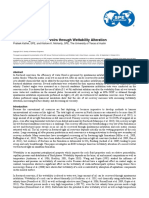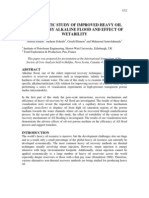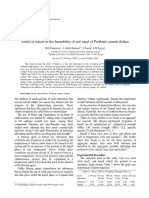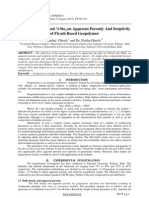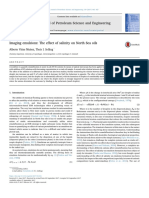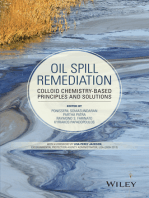A7 (1) Asdasdaasda
A7 (1) Asdasdaasda
Uploaded by
Abid HameedCopyright:
Available Formats
A7 (1) Asdasdaasda
A7 (1) Asdasdaasda
Uploaded by
Abid HameedOriginal Title
Copyright
Available Formats
Share this document
Did you find this document useful?
Is this content inappropriate?
Copyright:
Available Formats
A7 (1) Asdasdaasda
A7 (1) Asdasdaasda
Uploaded by
Abid HameedCopyright:
Available Formats
Int. J. Miner. Process.
83 (2007) 125 131
www.elsevier.com/locate/ijminpro
Rate of water transfer to flotation froth in the flotation of low-rank
coal that also requires the use of oily collector
Feridun Boylu a , Janusz S. Laskowski b,
a
Istanbul Technical University, Faculty of Mines, Mineral Profcessing Engineering Department, 34469 Maslak, Istanbul, Turkey
b
Department of Mining Engineering, University of British Columbia, Vancouver, B.C., Canada
Received 23 June 2007; received in revised form 14 July 2007; accepted 18 July 2007
Available online 1 August 2007
Abstract
The entrainment of hydrophilic gangue particles in flotation is related to the amount of water reporting to the froth. It is well
established that the amount of water reported to the froth is controlled by frother concentration. As it is shown in this paper, in the
flotation systems in which emulsified oily collector is also used (e.g. coal flotation), solids recovery strongly depends on the
collector dosages as also does the water recovery. While the tests carried out at low (1000 g/t) and high (8000 g/t) oil dosages show
different effects of frother additions on water transfer rates to the froth, all the experimental points when water transfer rates are
plotted versus solids transfer rates to the froth converge on one single curve. This suggests that the effect of both the frother and
collector on water transfer rates is first of all determined by the transfer of solids to the froth, and thus by the effect of these two
agents on the solids transfer to froth.
2007 Elsevier B.V. All rights reserved.
Keywords: Froth flotation; Coal flotation; Entrainment; Agglomerate flotation; Water recovery
1. Introduction
Frothers are utilized in flotation processes to enhance
generation of fine bubbles and to stabilize froth. The
effect of frothers on bubble size and foam stability has
been extensively studied and it was shown that the CCC
(critical coalescence concentration) and DFI (dynamic
foamability index) describe well frother ability to reduce bubble size and produce stable foam (Cho and
Laskowski, 2002; Laskowski et al., 2003; Grau et al.,
2005; Melo and Laskowski, 2006).
The frother concentration directly affects the bubble
size (by controlling bubble coalescence). Better selec Corresponding author.
E-mail addresses: boylu@itu.edu.tr (F. Boylu), jsl@apsc.ubc.ca
(J.S. Laskowski).
0301-7516/$ - see front matter 2007 Elsevier B.V. All rights reserved.
doi:10.1016/j.minpro.2007.07.003
tivity and higher recoveries are reported at finer bubble
sizes. The presence of frother also affects the amount of
water transferred to froth products (Rahal et al., 2001,
Melo and Laskowski, 2006) and thus affects entrainment of hydrophilic ultra fine gangue minerals (Engelbrecht and Woodburn, 1975; Trahar and Warren, 1976;
Warren 1985; Smith and Warren, 1998).
The relationship between frother characteristics
expressed by critical coalescence concentration (CCC)
and dynamic foamability index (DFI) and the effect of
frother on water recovery and entrainment were investigated by Melo and Laskowski (in press) who studied
different frothers in the flotation of metallurgical and lowrank coals. In case of three phase systems containing
also solid particles, these particles, their size, surface properties and concentration, affect froth characteristics
(Dippenaar, 1982; Johansson and Pugh, 1992; Tao et
126
F. Boylu, J.S. Laskowski / Int. J. Miner. Process. 83 (2007) 125131
Table 1
Proximate analysis of the tested coal
COAL Moisture, Ash,
%
%
Volatile
Volatile matter, Fixed carbon
matter, % d.m.m.f., %
d.m.m.f., %
LS-20 3.64
27.48
34.6
44.5
55.5
al., 2000; Schwartz and Grano, 2005). Although Malysa
(1998) suggested that while the presence of solid particles
affects foam stability and liquid contents in the foam, the
general relationships between the liquid content and
frother concentration measured in foams should not be
altered by the presence of solid particles, it is still unclear
how to use the information on the fundamental properties
of flotation frothers in predicting the behavior of the froth
in a real flotation system.
In flotation of some minerals so-called oily collectors, water-insoluble hydrocarbons, are utilized. For
instance, while flotation of bituminous coals can be
carried out using only a frother, in the flotation of less
hydrophobic, sub-bituminous coals (also anthracites and
oxidized coals), also a collector is required and commonly emulsified kerosene or diesel oil are used.
In general, oily hydrocarbons are known to flatten
froth in a flotation cell. However, the addition of oil to a
stirred suspension of fine hydrophobic particles leads to
agglomeration of these particles. The oil agglomeration
of fine coal by hydrocarbons relies on the formation of
large agglomerates strong enough to be separated by
screening from the pulp. With the oil dosages lower than
a few percent the recovery of combustible matter tend to
deteriorate since the agglomerates formed under such
conditions are not strong enough to withstand handling/
screening. But since the agglomerates formed at low oil
dosages result in a formation of loose aggregates which
easily entrap air bubbles such aggregates can be recovered by flotation, and a simultaneous use of a frother
provides quite good flotation results (Wojcik and AlTaweel, 1984; Bricker et al., 1991).
Thus, the effect of oil (e.g. diesel oil, kerosene) used
in the flotation tests with coal may result from: (i)
making coal particles more hydrophobic and thus facilitating particle-bubble attachment, or (ii) selective agglomeration of coal fines. It is difficult to discriminate
between the two mechanisms. Woodburn et al. (1984) in
their studies on coal flotation selected the conditions that
favour agglomeration of fine coal particles: very intense
conditioning (30 min at 1750 rpm in a Denver flotation
cell) and huge quantities of kerosene (3.5% to 17.7%).
They showed that water recovery in the froth product
that followed such a conditioning procedure strongly
increased with the dosage of oil. This was clearly the
case when the fine coal particles were agglomerated and
the agglomerates were recovered by flotation. The
flotation results of Melo and Laskowski (in press) were
obtained while working with a sub-bituminous coal
using only 3 kg of diesel oil/t of coal (0.3%). This oil
consumption was more than 10 times lower than in
Woodburn et al.'s tests. The emulsified diesel oil was
conditioned with pulp for 30 s only. The amount of
diesel oil that was used was sufficient to improve flotation (which was still poor with about 2025% yields
of the froth product) but the process was not likely to be
an agglomerate flotation. Thus, it seems that the water
transfer to the froth can be much lower if the used oil
makes the particles more hydrophobic but does not
produce agglomeration of the floating particles.
The objective of this research project was to study the
effect of both a frother (MIBC) and a collector (emulsified diesel oil) on water transfer to the froth, and
entrainment in flotation of a low-rank coal.
2. Materials and methods
2.1. Coal sample
A low-rank sub-bituminous coal (LS-20) provided by the
Luscar Sterco mine, Alberta, Canada, was used in the tests.
The sample was crushed and pulverized below 150 m (d90),
and kept in plastic bags for flotation tests. The proximate
analysis of coal and the X-ray analysis of coal mineral matter
are given in Tables 1 and 2, respectively.
2.2. Reagents
In flotation tests, emulsified diesel oil (EDO) and MIBC
(methyl iso-butyl carbinol) were used as collector and frother,
respectively. Following Good et al. (1994) who showed a very
positive effect of n-octanol on wettability of a low-rank coal
by liquid hydrocarbons, we emulsified diesel oil with a 2%
addition of n-decanol. Decanol was used in our tests since it is
practically insoluble in water and thus all added amount stays
in the organic phase. 2% by weight of decanol was added to
diesel oil and the system was heated up to 6070 C during
30 min of mixing. The solution of decanol in diesel oil was
Table 2
X-ray analysis of the mineral matter of LS-20 cal
Quartz
Muscovite
Kaolinite
Gypsum
Calcite
Total
Ideal formula
Coal LS-20
SiO2
KAl2 AlSi3O10(OH)2
Al2Si2O5(OH)4
CaSO4 2H2O
CaCO3
42.2
32.3
16.9
3.0
5.6
100.0
F. Boylu, J.S. Laskowski / Int. J. Miner. Process. 83 (2007) 125131
cooled down to room temperature. In emulsifying process
(performed in a Warring Blender at 21,000 rpm for 5 min) 5%
of the diesel oil containing 2% decanol was emulsified in
water. The prepared emulsion was stable and phase separation
was observed only after one week. All the flotation
experiments were performed with a freshly prepared emulsion.
2.3. Batch flotation tests
Flotation tests were carried out at 10% solids content by wt.
A 3 L Open-top Leeds flotation cell was used; the froth
products were collected at different froth thickness over 30 s
and 60 s intervals. The pulp level and froth thickness during the
flotation tests were controlled and maintained constant. The
entrainment degree was calculated by following the procedure
127
proposed by Warren (1985). In this procedure, the batch
flotation tests using only frother are performed; the ash
recoveries (%) and corresponding water amounts (%) are
determined for the certain flotation time intervals. Then, the
curve of Recovery of Ash (y axis) versus Recovery of
Water (x axis) is plotted and the slope of this curve giving an
intercept at y axis (inherent ash content at true flotation) is
assumed as entrainment degree. In our tests the entrainment
degrees were calculated at very low and very high emulsified
diesel oil doses. Our previous study (Boylu and Laskowski,
2006), which was focused on determination of entrainment
degree, indicated the lowest entrainment degree at the collector
dosage which was just enough to float hydrophobic particles.
Since the equation illustrating the relation between the
amount of water and solid particles content directly gives the
Fig. 1. Amount of water reporting to the froth as a function of: (a) EDO dosages, (b) frother concentration at 1000 g/t EDO, and (c) frother
concentration at 8000 g/t of EDO.
128
F. Boylu, J.S. Laskowski / Int. J. Miner. Process. 83 (2007) 125131
data similar to the entrainment degree, the experimental data
obtained in this study were evaluated depending on the initial
rate of water and solids transfer. The water transfer rates/initial
water transfer rates were calculated following the procedure
described by Melo and Laskowski (in press).
3. Results and discussion
3.1. Effect of EDO (emulsified diesel oil) and frother dosage
on water transfer to the froth
Since large water recoveries were reported by Woodburn et
al. (1984) at high oil dosages (agglomerate flotation), and low
by Boylu and Laskowski (2006) and Melo and Laskowski (in
press) at low oil dosages, we first tested the effect of the dosage
of emulsified oil. As Fig. 1a reveals, while low amount of
water is recovered in the froth at 1000 g/t and 2000 g/t of EDO,
the amount of water transferred to froth increases dramatically
at 6000 and 8000 g/t of EDO. The MIBC concentration was
kept constant in this first series of tests (7.2 ppm).
The two series of tests that followed were carried out at
1000 g/t of EDO (Fig. 1b) and 8000 g/t of EDO (Fig. 1c)
varying frother concentration. The effect of frother concentration is different in these two cases. With 1000 g/t of EDO in the
low MIBC concentrations range (1.2 ppm to 4.8 ppm)
increasing concentration of MIBC depressed the amount of
water transferred to froth, but this trend is reversed when the
MIBC concentrations was higher than 4.8. At high oil dosages
(8000 g/t of EDO), the water transfer to froth was high even at
low MIBC concentrations (2.4 ppm) and increased further
when this concentration was increased. These results then
confirm very well the findings reported by Woodburn et al.
(1984) at high oil dosages, and those of Melo and Laskowski
(in press) reported at low oil dosages.
More detailed information on the experiments with 8000 g/t
EDO is given in Fig. 2. As these figures demonstrate, the effect
Fig. 2. Effect of frother concentration and froth thickness on the amount of water transferred to the froth at 8000 g/t of EDO.
F. Boylu, J.S. Laskowski / Int. J. Miner. Process. 83 (2007) 125131
129
of frother concentration on the amount of water recovered in
froth (at 8000 g/t of EDO) is not very pronounced, especially
when the tests are carried out at a froth thickness of 3 cm (this is
also sown in Fig. 1c). It is obvious that under the conditions of
large dosages of EDO the amount of water is first of all
determined by the dosage of oil.
The initial rate of water transfer to froth is clearly dependant
on frother concentration at 1000 g/t of EDO (Fig. 3a) and does
not depend much on frother concentration at 8000 g/t of EDO
(Fig. 3b). Fig. 4 confirms that the water transfer to the froth is
affected and controlled by the oil dosages.
3.2. Effect of frother/EDO dosages on the initial water
transfer rates and the entrainment degree
Since the amount of water transferred to the froth is
generally linked to the entrainment degrees, and the amount of
water in froth and the entrainment degrees are controlled by
frother and frother/collector combinations, the effects of
frother and collector dosages were also examined.
Fig. 4. Effect of EDO dosages at 7.2 ppm of MIBC on water transfer
rates to froth. The data points for 4000 g/t and 6000 g/t of EDO
overlap.
The effects of EDO and frother (MIBC) concentrations on
the initial water transfer rates and entrainment degrees are
illustrated in Figs. 5 and 6. As seen from Fig. 5, the initial water
transfer rates to the froth increase and then remain constant at
the EDO concentrations higher than 4000 g/t. At EDO
concentrations lower than 4000 g/t the entrainment degrees
are practically constant, whereas at the higher EDO concentrations, although the water transfer rate was constant, the
entrainment degrees dramatically increase. This can possibly
be explained by particle agglomeration and likely entrapment
of some gangue particles within the loose agglomerates.
In this study, the entrainment degree was analyzed
following the procedure described by Warren (1985) and
150 m coal samples were used. As a matter of fact, since
Fig. 3. Dependence of the rate of water transfer on frother concentration at 1000 g/t of EDO (a) and 8000 g/t of EDO (b).
Fig. 5. Effect of EDO concentration on initial rate of water transfer and
entrainment degree.
130
F. Boylu, J.S. Laskowski / Int. J. Miner. Process. 83 (2007) 125131
Fig. 6. Summarized results illustrating the effect of frother concentration for two and three phase flotation systems. The froth thickness is
3 cm. The results for waterMIBC and waterMIBCcoal were taken
from Melo and Laskowski (2007). The empty points show the initial
mass recovery rate. CCCw f stands for the critical coalescence
concentration for the MIBCwater system.
only particles finer than 50 m can report to froth via
entrainment this analysis would have been more sensitive if the
tests had been carried out using such a fine fraction. Boylu and
Laskowski (2006) based their calculations of the entrainment
degree on the behavior of the 50 m size fraction by
extracting the data of the 50 m fraction from the complete
size distribution. The data in Fig. 5, however, represents the
floated material with its original size distribution. Since over
the higher than 4000 g/t EDO dosage range the water transfer
to the froth is constant, increasing entrainment degrees shown
in Fig. 5 in this EDO dosages range can be assigned to the
entrapment. As seen, the steepness of the entrapment curve
is Fig. 5 at low and high EDO dosages is very different. While
this steepness at low EDO dosages seems to represent a true
entrainment, the very steep portion of the curve at a high EDO
dosage should be ascribed to both entrapment and entrainment.
While Fig. 5 illustrates the effect of EDO dosages at a
certain frother concentration, Fig. 6 illustrates the effect of
frother concentration on initial rate of water transfer, and
accompanying entrainment degrees for two extreme EDO
dosages: 1000 g/t and 8000 g/t. Entirely different effect of
frother concentration on water transfer was found at the low
(1000 g/t) and high (8000 g/t) EDO dosages. At EDO dosage
of 8000 g/t, increasing frother concentration resulted in higher
water transfers but remained constant at the frother concentrations higher than 4.55 ppm. In contrast, for the 1000 g/t EDO
dosage, increasing frother concentration results in lower water
transfer rates to the froth and the lower entrainment degrees.
As in the previous case of high EDO dosages, the effect of
frother concentration entirely changes at the concentrations
higher than about 4 ppm.
Fig. 6 nicely confirms the correlation between the water
transfer rates to froth and entrainment degree. In both cases, a
low and high dosage of EDO, the correlation is good. Different
in both cases is the effect of frother concentration. The results
for the same coal quoted after Melo and Laskowski (in press)
and obtained at 3000 g/t EDO, are just situated between the
two extremes for low and high doses of EDO. So, while the
low dosages of EDO reduce the water transfer rates to froth, at
high dosages of EDO these water transfer rates are much
higher even at lower frother concentrations. Since increasing
dosages of oil can only increase hydrophobicity of coal
particles, these results suggest that while initial increase in
hydrophobicity of the floating particles reduces the water
transfer rates, at high coal particle hydrophobicity and high
dosages of emulsified oil some other factors must come to the
play.
These results imply that agglomerate flotation is taking
places at high oil dosages and they are consistent with
Woodburn et al. (1984) who reported that for high oil dosages
the amount of water transferred to froth was extremely high.
As already mentioned, several factors such as particle size,
hydrophobicity, nature of the collector etc., control water
transfer to froth. Zheng et al. (2006) evaluated different models
of water recovery in flotation. In one of these models the water
flow to concentrate is linked directly with the concentrate
solids flow rate. Fig. 7 shows the relationship between the
transfer rate of water to froth product and the mass transfer
rate of solids to froth product. As the correlation coefficients
calculated separately for 1000 g/t of EDO (empty circles in
Fig. 7) and for 8000 g/t of EDO (filled squares) show the
correlations are very good. This indicates that the solids
content in the froth may be a primary factor determining the
Fig. 7. Relationship between volumetric transfer rate of water to
concentrate and the mass transfer rate of solids to concentrate (Qw and
Fs represent the volumetric transfer rate of water and the mass transfer
rate of solids to froth products, respectively).
F. Boylu, J.S. Laskowski / Int. J. Miner. Process. 83 (2007) 125131
amount of water. If so, the collector and frother dosages affect
the water transfer to the froth only because they determine the
recovery of solids.
The obtained results seem to indicate that while the
flotation process at 1000 g/t resembles a typical emulsion
flotation, the process at 8000 g/t is probably an agglomerate
flotation. While in the former case the effect of the oily
collector results from making coal particles more hydrophobic,
in the latter case the overall effect results from agglomeration
of coal particles by added oil. In the low oil dosages range the
water transfer rates to froth are low, and so also low is the
entrainment (Fig. 5). This is very different at the high oil
dosages. In the range of oil dosages exceeding 4000 g/t the
water transfer rates are dramatically higher and so also much
higher are the entrainment degrees which can be possibly
linked to the particle agglomeration.
4. Conclusions
In this project, the effect of frother on the flotation of
low-rank coal with emulsified oily collector is studied.
Two different effects of frother concentration for two
extreme collector dosages were found: for low collector
dosages the flotation system requires higher frother
concentrations to reach the stable froth conditions,
for higher collector dosages selectivity deteriorates and
this is particularly clear when water transfer to froth is
monitored. The results imply that while at low oil dosages the presence of oil makes coal particles more
hydrophobic, at higher oil dosages the coal particles get
agglomerated.
References
Boylu, F., Laskowski, J.S., 2006. The true flotation and entrainment
in coal flotation. Proc. 15th Int. Coal Preparation Congress, vol. 1.
China University of Mining and Technology Press, Beijing,
pp. 406416.
Bricker, Y., Szymocha, K., Pawlak, W., Kramer, J., Ignasiak, B., 1991.
Feasibility of Aglofloat process for deashing and desulfurization of
high sulfur coals. In: Dugan, P.R., Quigley, D.R., Attia, Y.A.
(Eds.), Processing and Utilization of High-Sulfur Coals IV.
Elsevier, pp. 357376.
Cho, Y.S., Laskowski, J.S., 2002. Effect of flotation frothers on bubble
size and foam stability. Int. J. Miner. Process. 64, 6980.
131
Dippenaar, A., 1982. The destabilization of froth by solids. Int. J.
Miner. Process. 9, 114.
Engelbrecht, J.A., Woodburn, E.T., 1975. The effects of froth height,
aeration rate, and gas precipitation on flotation. J. South Afr. IMM
76, 125131.
Good, R.J., Badgujar, T.L.H., Huang, K., Handur-Kulkarni, S.N.,
1994. Hydrophilic colloids and the elimination of inorganic sulfur
from coal. Colloids Surf. 93, 3948.
Grau, A., R., Laskowski, J.S., Heiskanen, K., 2005. Effects of frothers
on bubble size. Int. J. Miner. Process. 76, 225233.
Johansson, G., Pugh, R.J., 1992. The influence of particle size and
hydrophpobicity on the stability of mineralized froth. Int. J. Miner.
Process. 34, 121.
Laskowski, J.S., Tlhone, T., Williams, P., Ding, K., 2003. Fundamental
properties of the polyoxypropylene alkyl ether flotation frothers.
Int. J. Miner. Process. 72, 299.
Malysa, K., 1998. Water contents and distribution in flotation froth. In:
Laskowski, J.S., Woodburn, E.T. (Eds.), Frothing in Flotation II.
Gordon and Breach, pp. 81108.
Melo, F., Laskowski, J.S., 2006. Fundamental properties of flotation
frothers and their effect on flotation. Miner. Eng. 19, 766773.
Melo, F., Laskowski, J.S., in press. Effect of frothers and solid particles
on the rate of water transfer to the froth". Int. J. Miner. Process.
Rahal, K., Manlapig, E., Franzidis, J.P., 2001. Effect of frother type
and the concentration on the water recovery and entrainment
recovery relationship. Miner. Metall. Process. 18, 138141.
Smith, P.G., Warren, L.J., 1998. Entrainment of particles into flotation
froths. In: Laskowski, J.S. (Ed.), Frothing in flotation. Gordon and
Breach, pp. 123145.
Schwartz, S., Grano, S., 2005. Effect of particle hydrophobicity on
particle and water transport across a flotation froth. Colloids Surf.
256, 157164.
Tao, D., Luttrell, G.H., Yoon, R.H., 2000. A parametric study of froth
stability and its effect on column flotation of fine particles. Int. J.
Miner. Process. 59, 2543.
Trahar, W.J., Warren, L.J., 1976. The floatability of very fine particles
a review. Int. J. Miner. Process. 3, 103131.
Warren, L.J., 1985. Determinations of the contributions of true
flotation and entrainment in batch flotation tests. Int. J. Miner.
Process. 14, 3344.
Wojcik, W., Al-Taweel, A.M., 1984. Beneficiation of coal fines by
aggregative flotation. Powder Technol. 40, 179185.
Woodburn, E.T., Flynn, S.A., Cressey, B.A., Cressey, G., 1984. The
effect of froth stability on the beneficiation of low-rank coal by
flotation. Powder Technol. 40, 167177.
Zheng, X., Franzidis, J.P., Johnson, N.W., 2006. An evaluation of
different models of water recovery in flotation. Miner. Eng. 19,
871882.
You might also like
- WhatDocument11 pagesWhatgemmajustriboNo ratings yet
- Effect of Salinity On Oil Recovery by Spontaneous ImbibitionDocument12 pagesEffect of Salinity On Oil Recovery by Spontaneous ImbibitionRosa K Chang HNo ratings yet
- The Impact of Pore Water Chemistry On Carbonate Surface Charge and Oil WettabilityDocument23 pagesThe Impact of Pore Water Chemistry On Carbonate Surface Charge and Oil WettabilityLazuardhy Vozicha FuturNo ratings yet
- 10 1016@j Petrol 2015 10 005Document18 pages10 1016@j Petrol 2015 10 005IkhsanjauharitsanyNo ratings yet
- 1-2003-Laskowski Et Al-2003-The Canadian Journal of Chemical EngineeringDocument7 pages1-2003-Laskowski Et Al-2003-The Canadian Journal of Chemical EngineeringjvchiqueNo ratings yet
- Enhanced Oil Recovery by Low-Salinity Water Spontaneous ImbibitionDocument10 pagesEnhanced Oil Recovery by Low-Salinity Water Spontaneous ImbibitionLusiana OliviaNo ratings yet
- MEORaksel Mechanism PDFDocument13 pagesMEORaksel Mechanism PDFmuh. yusufNo ratings yet
- SPE-183086-MS LSF CarbonateDocument20 pagesSPE-183086-MS LSF CarbonateEnggela LarwuyNo ratings yet
- Fluid Density and Viscosity Effects On Borehole Resistivity Measurements Acquired in The Presence of Oil Based Mud and Emulsified SurfactantDocument16 pagesFluid Density and Viscosity Effects On Borehole Resistivity Measurements Acquired in The Presence of Oil Based Mud and Emulsified Surfactantadib assoliNo ratings yet
- Art 3A10.1007 2Fs12182 010 0030 ZDocument6 pagesArt 3A10.1007 2Fs12182 010 0030 ZPritesh BhoumickNo ratings yet
- SPE 166281 EOR in Tight Oil Reservoirs Through Wettability AlterationDocument15 pagesSPE 166281 EOR in Tight Oil Reservoirs Through Wettability AlterationAkashShuklaNo ratings yet
- Aglomeración de CarbónDocument9 pagesAglomeración de CarbónLucas RossiniNo ratings yet
- 23 SofraDocument10 pages23 SofraDavid BenaventeNo ratings yet
- Buchgraber 2012Document22 pagesBuchgraber 2012Javier E. Guerrero ArrietaNo ratings yet
- Minerals Engineering: J.M. Sovechles, M.R. Lepage, B. Johnson, K.E. WatersDocument9 pagesMinerals Engineering: J.M. Sovechles, M.R. Lepage, B. Johnson, K.E. WatersJose Luis Barrientos RiosNo ratings yet
- Energies: Study of The Effect of Clay Particles On Low Salinity Water Injection in Sandstone ReservoirsDocument12 pagesEnergies: Study of The Effect of Clay Particles On Low Salinity Water Injection in Sandstone ReservoirsRavi ShankarNo ratings yet
- Department o F Earth and Planetary Sciences, Massachusetts Institute of Technology. Cambridge, Mass. 02139, USADocument10 pagesDepartment o F Earth and Planetary Sciences, Massachusetts Institute of Technology. Cambridge, Mass. 02139, USAillaNo ratings yet
- IntroductionDocument6 pagesIntroductionSarah AlaaNo ratings yet
- 1 s2.0 S0892687513002276 MainDocument5 pages1 s2.0 S0892687513002276 MainDaniela NarvaezNo ratings yet
- Chemical Geology: Cheng Peng, John P. Crawshaw, Geoffrey C. Maitland, J.P. Martin TruslerDocument12 pagesChemical Geology: Cheng Peng, John P. Crawshaw, Geoffrey C. Maitland, J.P. Martin TruslerDiego Alex Cahuaya MamaniNo ratings yet
- Quartz Dissolution EnergygeosciDocument8 pagesQuartz Dissolution EnergygeosciAbdullah Musa AliNo ratings yet
- Minerals Engineering: O. Ramos, S. Castro, J.S. LaskowskiDocument5 pagesMinerals Engineering: O. Ramos, S. Castro, J.S. LaskowskijvchiqueNo ratings yet
- The Enhanced Flotation of Coal by Nanosilica ParticlesDocument14 pagesThe Enhanced Flotation of Coal by Nanosilica ParticlesKumarNo ratings yet
- Spe 150953 MSDocument22 pagesSpe 150953 MSamin peyvandNo ratings yet
- 1 s2.0 S0043135412005167 Mainext PDFDocument9 pages1 s2.0 S0043135412005167 Mainext PDFJustina Ines TroianNo ratings yet
- Comparing The Effect of Salts and Frother (MIBC) On Gas Dispersion and Froth PropertiesDocument7 pagesComparing The Effect of Salts and Frother (MIBC) On Gas Dispersion and Froth PropertiesJose Luis Barrientos RiosNo ratings yet
- OTC-29732-MS Recent Updates On Smart Water EOR in LimestoneDocument11 pagesOTC-29732-MS Recent Updates On Smart Water EOR in LimestonesaeedNo ratings yet
- A Parametric Study of Froth Stability and Its EffectDocument19 pagesA Parametric Study of Froth Stability and Its EffectJuan OlivaresNo ratings yet
- Spe 169127 Pa - 01Document16 pagesSpe 169127 Pa - 01Gabriel TexeraNo ratings yet
- Flotation Frother Mixtures - Decoupling The Sub-Processes of Froth Stability, Froth Recovery and EntrainmentDocument8 pagesFlotation Frother Mixtures - Decoupling The Sub-Processes of Froth Stability, Froth Recovery and EntrainmentJose Luis Barrientos RiosNo ratings yet
- Experimental Study of Combined Low Salinity and Surfactant Ooding Effect On Oil RecoveryDocument9 pagesExperimental Study of Combined Low Salinity and Surfactant Ooding Effect On Oil RecoveryPamela Rodrigues RodriguesNo ratings yet
- Stipp and Tullis 2006Document19 pagesStipp and Tullis 2006maskilj.msgl022003No ratings yet
- Mechanistic Study of Improved Heavy Oil Recovery by Alkaline Flood and Effect of WetabilityDocument12 pagesMechanistic Study of Improved Heavy Oil Recovery by Alkaline Flood and Effect of WetabilityRosa K Chang HNo ratings yet
- Wettability Alteration of Sandstone and Carbonate Rocks by Using Zno Nanoparticles in Heavy Oil ReservoirsDocument17 pagesWettability Alteration of Sandstone and Carbonate Rocks by Using Zno Nanoparticles in Heavy Oil ReservoirsRizq NafhanNo ratings yet
- Metallurgy FlotationDocument7 pagesMetallurgy FlotationcaflitaNo ratings yet
- Effect of Frothers and Dodecylamine On Bubble Size and Gas Holdup in A Downflow Column PDFDocument7 pagesEffect of Frothers and Dodecylamine On Bubble Size and Gas Holdup in A Downflow Column PDFJose Luis Barrientos RiosNo ratings yet
- S. Iglauer, A. Paluszny, M.J. Blunt: Contents Lists Available atDocument10 pagesS. Iglauer, A. Paluszny, M.J. Blunt: Contents Lists Available atKilaparthi SatyavammaNo ratings yet
- Otc 30449 MsDocument9 pagesOtc 30449 MsdiditkusumaNo ratings yet
- Mechanisms of Improved Oil Recovery From Sandstone by Low Salinity FloodingDocument12 pagesMechanisms of Improved Oil Recovery From Sandstone by Low Salinity FloodingRosa K Chang HNo ratings yet
- Abdullah (2018) Fines Migration As An EOR Method During LSWDocument14 pagesAbdullah (2018) Fines Migration As An EOR Method During LSWAdzan Topaz AdityaNo ratings yet
- Effect of Self-Healing On The Chloride Diffusivity at Early AgeDocument8 pagesEffect of Self-Healing On The Chloride Diffusivity at Early AgemarcNo ratings yet
- Minerals Engineering: Avishan Atrafi, Marek PawlikDocument10 pagesMinerals Engineering: Avishan Atrafi, Marek PawlikJose Luis Barrientos RiosNo ratings yet
- Otc 24470 MSDocument13 pagesOtc 24470 MSkpratik41No ratings yet
- CaracterizciónDocument7 pagesCaracterizciónandrea.cipagautaNo ratings yet
- Article Rock Water Interaction Low-Salinity Impact On The Properties of The Porous Medium Dissolution C Angarita S SolerDocument11 pagesArticle Rock Water Interaction Low-Salinity Impact On The Properties of The Porous Medium Dissolution C Angarita S SolerJorge Andrés TovarNo ratings yet
- Comparison of Three Methods of Relative Permeability MeasurementDocument16 pagesComparison of Three Methods of Relative Permeability MeasurementRosa K Chang HNo ratings yet
- Marine Pollution Bulletin: Yu-Ling Wei, Chang-Yuan Lin, Kuan-Wei Ko, H. Paul WangDocument6 pagesMarine Pollution Bulletin: Yu-Ling Wei, Chang-Yuan Lin, Kuan-Wei Ko, H. Paul WangFernando Volpatto RamosNo ratings yet
- Design of Experiments To Evaluate Clay Swelling Inhibition by DifferentDocument7 pagesDesign of Experiments To Evaluate Clay Swelling Inhibition by DifferentRyan AlifNo ratings yet
- Experimental Evaluation of Foams Stabilized by Ionic L - 2023 - Journal of CO2 UDocument9 pagesExperimental Evaluation of Foams Stabilized by Ionic L - 2023 - Journal of CO2 Uสราญศิริ วงศ์ศิริNo ratings yet
- J Petrol 2021 108647Document11 pagesJ Petrol 2021 108647fjNo ratings yet
- Effet Basalte Sur CimentDocument7 pagesEffet Basalte Sur CimentTarek FennicheNo ratings yet
- Adsorption of Surfactants o N Minerals For Wettability Control in Improved Oil Recovery ProcessesDocument15 pagesAdsorption of Surfactants o N Minerals For Wettability Control in Improved Oil Recovery ProcessesHanazawaRikkuNo ratings yet
- Asphaltene Deposition During CO Flooding: R.K. SrivastavaDocument11 pagesAsphaltene Deposition During CO Flooding: R.K. SrivastavaSergio FloresNo ratings yet
- Investigation of Smart Waterflooding in Sandstone Reservoirs: Experimental and Simulation Study Part 2Document11 pagesInvestigation of Smart Waterflooding in Sandstone Reservoirs: Experimental and Simulation Study Part 2Farid AndriadiNo ratings yet
- IOSRJEN (WWW - Iosrjen.org) IOSR Journal of EngineeringDocument6 pagesIOSRJEN (WWW - Iosrjen.org) IOSR Journal of EngineeringIOSRJEN : hard copy, certificates, Call for Papers 2013, publishing of journalNo ratings yet
- Percentage of Compounds Constituting The Tarfayas Oil Shale (Morocco) Reacting To Acid Attack (HCL)Document13 pagesPercentage of Compounds Constituting The Tarfayas Oil Shale (Morocco) Reacting To Acid Attack (HCL)IJAR JOURNALNo ratings yet
- Tetteh 2018Document20 pagesTetteh 2018Mohamed SnosyNo ratings yet
- Moisture Influence On Compressive Strength of Ternary Gypsum-Based BindersDocument5 pagesMoisture Influence On Compressive Strength of Ternary Gypsum-Based BindersIS AANo ratings yet
- Spe 132608 MS PDFDocument14 pagesSpe 132608 MS PDFGabriel EduardoNo ratings yet
- Journal of Petroleum Science and Engineering: Alberto Vi Nas Mu Noz, Theis I. SøllingDocument5 pagesJournal of Petroleum Science and Engineering: Alberto Vi Nas Mu Noz, Theis I. SøllingAlexander LopezNo ratings yet
- Oil Spill Remediation: Colloid Chemistry-Based Principles and SolutionsFrom EverandOil Spill Remediation: Colloid Chemistry-Based Principles and SolutionsNo ratings yet
- OEKO-TEX® - Limit Values and FastnessDocument11 pagesOEKO-TEX® - Limit Values and FastnessAbid HameedNo ratings yet
- Coal Flotation OF FinesDocument7 pagesCoal Flotation OF FinesAbid HameedNo ratings yet
- CarboDocument7 pagesCarboAbid HameedNo ratings yet
- Abid CVDocument2 pagesAbid CVAbid HameedNo ratings yet
- Experiments 8,9,10Document4 pagesExperiments 8,9,10Abid HameedNo ratings yet
- Objective: Apparatus:: Solenoid ValveDocument4 pagesObjective: Apparatus:: Solenoid ValveAbid HameedNo ratings yet
- Ei 1001 Fibre Optics and Laser Instruments 3 0 0 100Document2 pagesEi 1001 Fibre Optics and Laser Instruments 3 0 0 100Hari KumarNo ratings yet
- Color Distribution of A Shade Guide in The Value, Chroma, and Hue ScaleDocument11 pagesColor Distribution of A Shade Guide in The Value, Chroma, and Hue ScaleHarmath ZsofiaNo ratings yet
- Americae Sive Qvartae Orbis Partis Nova Et Exactissima Descriptio Library of CongressDocument1 pageAmericae Sive Qvartae Orbis Partis Nova Et Exactissima Descriptio Library of Congresssalmamourad2313No ratings yet
- BESSELDocument5 pagesBESSELLinearNo ratings yet
- Graph Theory Lecture-IDocument3 pagesGraph Theory Lecture-Ipallavi mahajanNo ratings yet
- 1941Document4 pages1941iwanNo ratings yet
- DD Env 1991 2 2 1996 PDFDocument49 pagesDD Env 1991 2 2 1996 PDFVishwakarma VishwakarmaNo ratings yet
- Curriculum Map: First Quarter-Earth and Space Key Stage StandarsDocument13 pagesCurriculum Map: First Quarter-Earth and Space Key Stage StandarsLeendeen Grace Solis SesdoyroNo ratings yet
- Questions Bank On ELECTROSTATICSDocument3 pagesQuestions Bank On ELECTROSTATICSAlok ShawNo ratings yet
- IT ManagerDocument2 pagesIT ManagerRuppee EdwardNo ratings yet
- FunctionsDocument50 pagesFunctionsPavanReddyReddyNo ratings yet
- De Chaisemartin D Haultfœuille 2020 Two Way Fixed Effects Estimators With Heterogeneous Treatment EffectsDocument35 pagesDe Chaisemartin D Haultfœuille 2020 Two Way Fixed Effects Estimators With Heterogeneous Treatment EffectsKlaus HoeltgebaumNo ratings yet
- Manual FFHH Oaci (Ingles)Document335 pagesManual FFHH Oaci (Ingles)Pran Antonio EscobarNo ratings yet
- Cumulus Linux 101Document96 pagesCumulus Linux 101Ricardo OrtizuNo ratings yet
- Pre-Standard: Publicly Available SpecificationDocument84 pagesPre-Standard: Publicly Available SpecificationNalex GeeNo ratings yet
- Working With Affymetrix Data: Estrogen, A 2x2 Factorial Design ExampleDocument15 pagesWorking With Affymetrix Data: Estrogen, A 2x2 Factorial Design ExampleCharles WangNo ratings yet
- Diary of Anne Frank EssayDocument5 pagesDiary of Anne Frank Essayafibykkhxxhdid100% (2)
- 13a SAWARD 2010Document106 pages13a SAWARD 2010HannahMaruci0% (1)
- 1.tahograful Analog MTCO 1324Document152 pages1.tahograful Analog MTCO 1324Lavinia Andreea BeldieNo ratings yet
- Natural Selection PhET SimulationDocument4 pagesNatural Selection PhET SimulationChris WalczakNo ratings yet
- Class 7 English Book 21Document12 pagesClass 7 English Book 21neha.stkvNo ratings yet
- Tieng Anh Tham Khao 1Document7 pagesTieng Anh Tham Khao 1Ngô Duy Quý ArtNo ratings yet
- Organisational BehaviourDocument279 pagesOrganisational Behaviouranjanaindia3542100% (22)
- Khawaja Fareed University of Engineering & Information Technology (KFUEIT) Rahim Yar KhanDocument6 pagesKhawaja Fareed University of Engineering & Information Technology (KFUEIT) Rahim Yar Khanasfand shaheryarNo ratings yet
- On Some Aspects of The Historiography of Colonial India (1982)Document4 pagesOn Some Aspects of The Historiography of Colonial India (1982)Piero Donnini ArezzoNo ratings yet
- Effect SizeDocument3 pagesEffect Sizekinhai_seeNo ratings yet
- How To Take Care of An Egg Baby ProjectDocument3 pagesHow To Take Care of An Egg Baby Projectzzaentz0% (1)
- Thunderstorm Power PointDocument17 pagesThunderstorm Power PointCrystal PennypackerNo ratings yet










